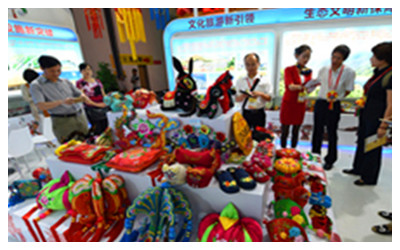Skype: neodalle-travel
Tel: +86 135 7447 2266
E-mail: sales@zhangjiajieholiday.com

Qingyang is habitually called 'Long Dong' because of its locality in eastern Gansu province.Qingyang city is known as "Longdong Basin" for its geographic location. Well-known as "Longdong Granary", Qingyang has an abundant amount of grains, including wheat, corn and buckwheat. A colorful folk culture is alive in Qingyang, including crafts such as perfumed pouches, paper-cuts and shadow puppets in addition to folk customs such as yangge, shehuo (a traditional activity to celebrate the earth god and the fire ancestor) and pit kiln houses that feature a distinctive Loess Plateau style.
Qingyang Facts
Geogaraphy of Qingyang
Located in the east of Gansu province, Qingyang is also known as Longdong (long is short for Gansu and dong means east). With a total area of 27,119 square kilometers, the city runs 207 kilometers north to south and 208 kilometers east to west. It has seven counties and one district. The altitude of Qingyang ranges from 885 meters to 2,082 meters. Its average altitude is 1,421 meters. Qingyang is the “top plateauof loess in the world,” surpassing other loess plateaus in terms of area, soil thickness and conservation. Ziwu Mountain in the southeast of the city is rich in trees, water and grass.
History of Qingyang
The fossils of Huanjiang Pterosaur and the Yellow River Elephant, two major archaeological discoveries at the national level, were found in Qingyang. As a symbol of China’s Paleolithic Age, the first stone tool in China was unearthed in Qingyang’s Huachi county. A total of nearly 1,000 archaeological relics, including Yangshao Culture (which proliferated during the late Neolithic Age in Henan, Shaanxi, Shanxi, southern Hebei and eastern Gansu), Qijia Culture (which existed during the early Bronze Age and was distributed around the upper Yellow River region of Gansu and eastern Qinghai) and ancient buildings, are scattered throughout the city. The relics of the Great Wall built in the Warring States Period (475-221BC) can be found in Qingyang. Qingyang’s Beishi Grottoes are one of the four top grottoes in Gansu.
Transortation of Qingyang
It serves as a “natural reservoir” for the city’s secondary forest (a forest that has regrown after a major disturbance), which covers over 31.33 hectares. Two main roads, National Highway 211 and Provincial Highway 202, run through the city from south to north. National Highway 209 and Provincial Highway 303 run from east to west. The expansion of Qingyang Airport was completed in accordance with 4C standards; its terminal building is currently under construction. Qingyang has a continental climate with distinct seasons. Precipitation in the south of the city is greater than in the north. The annual average precipitation was 366.2~694.8 millimeters in 2011. The heaviest rain occurs in July, August and September. Temperatures are cooler in the north than in the south, and the annual average temperature is 8.6 C~9.9 C. Its sunshine duration is 1,909 to 2,392 hours.
Resource of QIngyang
Qingyang city is known as "Longdong Basin" for its geographic location. It is located on the Loess Plateau in the middle reaches of the Yellow River and has several gullies dividing it into several plateaus. There are 12 large plateaus in Qingyang measuring a total of 270,000 hectares. Most of the city’s agricultural products are sourced from this area. Well-known as "Longdong Granary", Qingyang has an abundant amount of grains, including wheat, corn and buckwheat.
Economy of QIngyang
 Qingyang was approved as a strong apple production area by the Ministry of Agriculture. It is also a production base for high-quality agricultural and livestock products. Moreover, China’s largest pumpkin seeds processing and exporting base and apricot products processing base are located in Qingyang. Qingyang also has abundant day lilies and a strong traditional Chinese medicine culture. Five rivers and 27 river branches run through the city.
Qingyang was approved as a strong apple production area by the Ministry of Agriculture. It is also a production base for high-quality agricultural and livestock products. Moreover, China’s largest pumpkin seeds processing and exporting base and apricot products processing base are located in Qingyang. Qingyang also has abundant day lilies and a strong traditional Chinese medicine culture. Five rivers and 27 river branches run through the city.
The city is a chemical industry base for petroleum and natural gas in Gansu province. It is also the main production area of the Changqing Oilfield. The amount of proven petroleum and natural gas totals 4 billion tons, accounting for 41 percent of all natural resources in the Ordos Basin. Qingyang's proven coal resources total 14 billion tons.
Qingyang's GDP was 45.43 billion yuan ($7.46 billion) in 2011, 16.8 percent greater than the previous year. The added value of the primary industry was 5.82 billion yuan, growing 6.8 percent from 2010. The secondary industry's added value increased 21.2 percent from 2010 to 2011 to reach 28.8 billion yuan. The tertiary industry's added value increased 10.81 billion yuan, a growth of 12.4 percent from 2010.
Folk culture of Qingyang
A colorful folk culture is alive in Qingyang, including crafts such as perfumed pouches, paper-cuts and shadow puppets in addition to folk customs such as yangge (a popular rural folk dance), shehuo (a traditional activity to celebrate the earth god and the fire ancestor) and pit kiln houses that feature a distinctive Loess Plateau style.
Social undertaking
Its working population grew by 3,877 from 2010 to 2011 to reach 96,523, a growth rate of 4.2 percent. A total of 7,804 unemployed workers found jobs in 2011. The urban unemployment rate was 3.63 percent by the end of 2011. Service revenues increased 12.1 percent since 2010 to 5.93 billion yuan. Higher education institutes in Qingyang have recruited 4,046 students in total this year. With an investment of 17.69 million yuan, the city’s scientific and technological projects at the national, provincial and municipal level totaled 283, including one national-level and 24 provincial-level projects,
A total of nine sports meets above the county level were held in 2011, welcoming a total of 1,790 participating athletes. Qingyang has won 25 medals in sports meets above the municipal level, including 12 gold medals, six silver medals and seven bronze medals. There are 29 hospitals in the city with a total of 6,484 beds. The health labor in the city totals 6,991, including 2,188 practicing physicians, 624 assistant practicing physicians, 2,160 registered nurses and 307 pharmacists.
 Ask Questions ?
Ask Questions ?